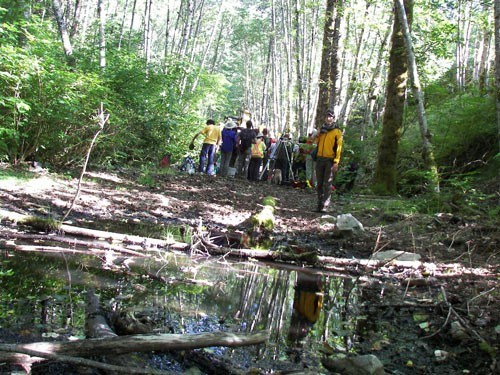A group of big kids have a budget to make some really expensive mud puddles to help save Northern Red-legged Frogs.
More than 30 wetland stewards learning how to build new wetlands gathered on Friday, July 13 at Retta Lake Road near Pinecrest to build two groundwater wetlands.
They did the same thing Saturday just south of Brohm Lake on a piece of decommissioned road below Highway 99. Neil Fletcher of the BC Wildlife Federation coordinated with Edith Tobe of the Squamish River Watershed Society to build three new wetlands at a location where three similar wetlands were created last August. Tobe said the wetlands created last year were built in an area that once served as Highway 99 before the route was upgraded more than 30 years ago. The wetlands, which look like little more than mud puddles to untrained eyes, proved very successful.
“There’s red-legged frogs in each of these ponds,” said Tobe as she addressed a group of people from all over B.C. learning about wetland construction. “To me this is very successful, very exciting.”
She told the group that the wetlands built last year were constructed using liners and three more planned for construction this weekend will also incorporate the use of liners.
The wetlands created last year were monitored and through the monitoring it was discovered that bats have also been attracted to the new habitat. Tobe told the group that a wetland like the ones created last year cost about $5,000 to build.
The Committee on the Status of Endangered Wildlife in Canada (COSEWIC) considers the red-legged frogs a nationally listed Special Concern species and the frogs are also on the provincial Blue List, which means the province also considers the species a special concern.
Check back for more on the conservation project.




